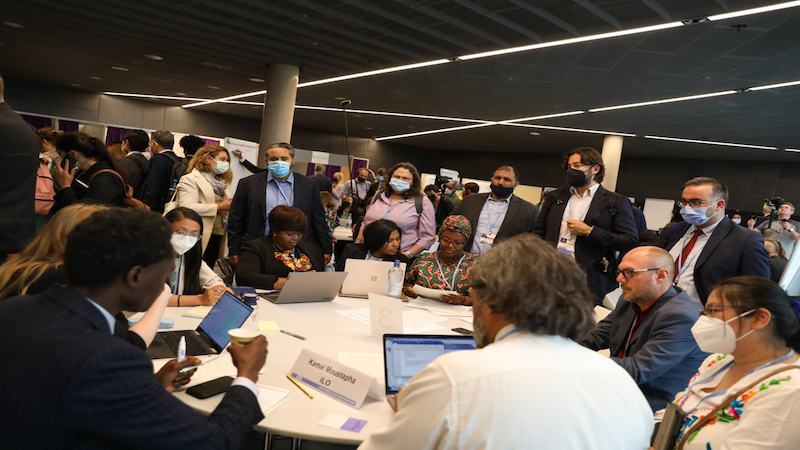The first Global Stocktake will tell us collective efforts need to be stepped up to reach the Paris Agreement goals. The question is how countries will respond to it.
As governments signed up to the Paris agreement in 2015, they committed to officially checking in at the end of 2023 on how the fight against climate change is going.
This health check is known as the global stocktake and work toward it began at Cop26 in Glasgow in 2021.
After a lot of hard work, it now entering the home stretch before taking centre stage when governments gather at the Cop28 climate talks in Dubai.
It will tell us whether enough is being done on cutting emissions, adapting to climate change, funding climate action and rolling-out technology.
The answer is widely expected to be a resounding ‘no’. But observers hope the latest wake-up call will prompt countries to correct course and raise their efforts.
For Simon Stiell, the head of the UN’s climate change arm, the stocktake will be a moment of truth. “It must tell us where we are, where we need to go, and how we’ll get there”, he said.
A two-year process
Its final report will be the culmination of an extensive two-year process. Thousands of documents have been analysed and distilled through hundreds of hours of discussions.
Analysts don’t expect the stocktake to say anything particularly new. Report after report has already said the world is falling short.
But its findings will form the basis of the discussions at Cop28. Political leaders will reflect on them and may come up with a plan to fix their shortcomings.
German official sees ‘a chance’ Cop28 can agree to phase out fossil fuels
Tom Evans, climate diplomacy analyst at E3G, hopes the stocktake will be “a launchpad for action going forward”.
The Stockholm Environment Institue’s Richard Klein, who is involved in the process, says there is lots of curiosity about how countries will react. “Are they going to commit to greater ambition or simply express concern once again?” he asked
Why a stocktake?
The stocktake is the central tool of the Paris Agreement to hold countries accountable for their collective efforts to achieve the targets they set themselves in 2015.
It tracks progress made on the pact’s three pillars: cut greenhouse gas emissions enough to limit global temperature rise to well below 2°C and ideally 1.5°C; strengthen resilience to climate impacts; and provide the necessary financial and technological means to make this happen.
UN: World set to blow through 1.5C carbon budget in 10 years
The stocktake is a core component of the so-called ‘ratchet mechanism’ built into the agreement.
It was clear from the outset that initial climate pledges would not be sufficient to meet the goals set in Paris. So the agreement encourages countries to raise their ambitions over time.
A virtuous circle
Carried out every five years from 2023, the stocktake is meant to guide countries as they update and enhance their pledges to bring them in line with the agreement.
At the heart of the exercise are the Nationally determined contributions (NDCs): each country’s individual strategy to reduce emissions and adapt to climate impacts.
The process should create a virtuous circle. The collective analysis of all NDCs submitted by the 193 countries which signed the Paris agreement forms the basis for the stocktake’s findings. These will in turn inform the drafting of new and more robust NDCs.
The two-year stocktake is divided into three phases: the collection of source material; the technical assessment; the consideration of its output at a political level.
The first two phases – which overlap – are soon drawing to a close.
Information gathering
The volume of the material inputted into the exercise is massive. Countries and non-state actors have submitted thousands of documents.
The bulk of it is made up of the signatories’ NDCs, national adaptation plans, finance reports and technology needs assessments.
Add to this the IPCC scientific reports, technical analysis prepared by the UN climate change Secretariat and a long list of disparate contributions by NGOs.
Reporting on climate adaptation is a mess – here’s how to fix it
“Just considering the adaptation chapter, if we put together what countries have written over the past few years it adds up to 18,000 pages,” says Richard Klein. “No one is going to be able to read all of that.”
The UN climate change secretariat has a coordinating role in sifting through the vast mass of information and preparing briefings and synthesis reports.
Technical analysis
This material is then analysed and discussed during the technical assessment. This second phase of the stocktake will have lasted for one year when it formally ends at the annual Bonn climate talks in June.
The assessment culminates in a series of in-person meetings of country delegates and experts in an ‘open and transparent’ process. After reviewing the inputs, they are expected to come up with the key takeaways on the collective efforts to uphold the Paris Agreem
Read More







Never miss a story. Join us on social.